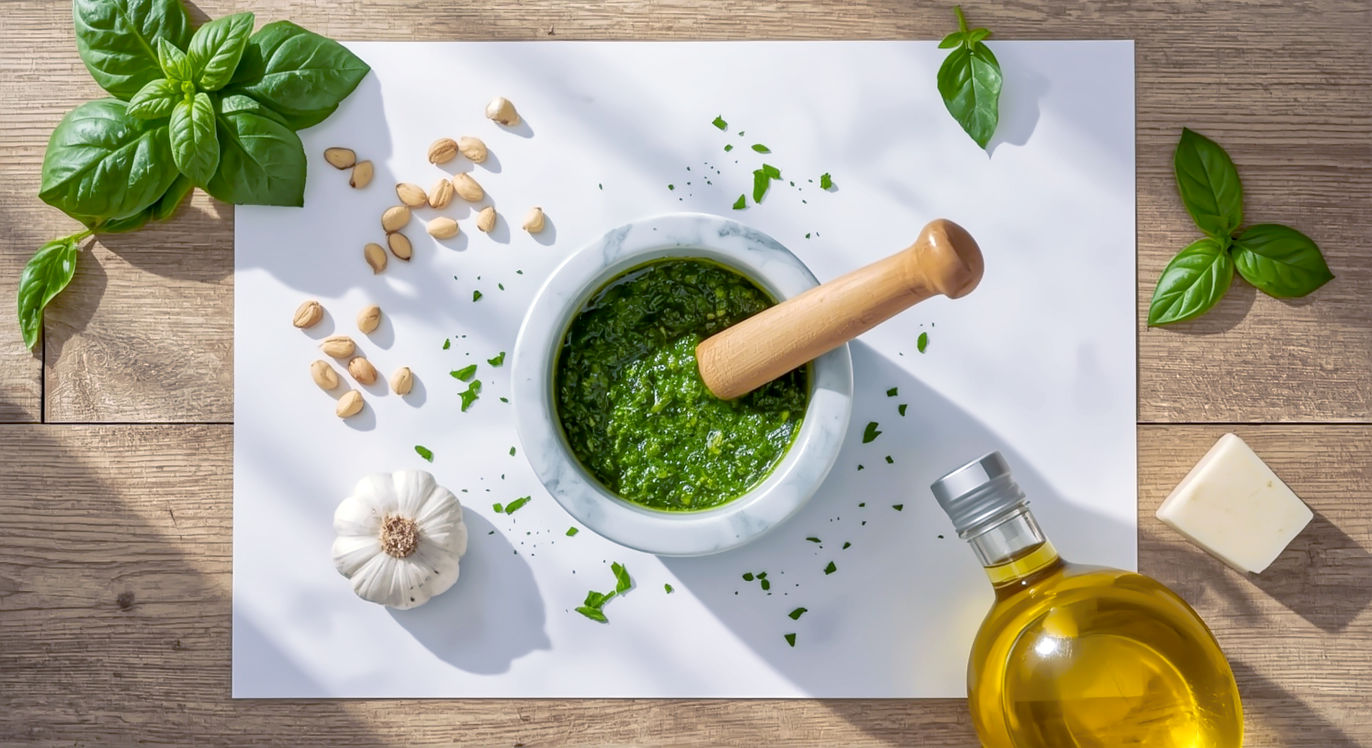Green Gold: The Guide to Fresh Pesto, from Garden to Table
Forget jarred pesto forever. Discover the secrets to making vibrant, fragrant homemade pesto with our ultimate guide for British home cooks.

This post may contain affiliate links. If you make a purchase through these links, we may earn a commission at no additional cost to you.
There’s a certain magic to fresh pesto. It’s more than just a sauce; it’s a burst of summer, a taste of the Italian Riviera, and a triumph of simplicity. That vibrant, electric green colour and the scent of freshly crushed basil can transport you from a dreary British afternoon straight to a sun-drenched terrace in Liguria.
But for many of us, pesto is simply that handy jar we grab from the supermarket shelf. It’s the quick, reliable fix for a midweek pasta dinner when you can’t be bothered to cook properly. We’ve become so used to the muted, slightly sludgy green of the jarred stuff that we’ve forgotten what real pesto is: a glorious, bright, and intensely fragrant sauce that’s shockingly easy to make at home.
This isn’t just another recipe. This is the story of pesto. It’s a journey that starts in the salty sea air of Genoa, travels through history, and ends right in your kitchen—or perhaps even your back garden. We’ll dive into the secrets of the seven essential ingredients, settle the age-old debate between the traditional mortar and pestle and the modern food processor, and show you how to create a sauce so good, you’ll swear off the jarred stuff for life. Whether you’ve got a sprawling country garden or a single pot on a city balcony, you can master the art of “green gold.” So, let’s begin.
What Exactly Is Pesto? The Seven Sacred Ingredients
At its heart, Pesto alla Genovese (pesto from Genoa) is a beautiful, uncooked sauce made from just seven ingredients. It’s a perfect example of how Italian cooking takes simple, high-quality produce and turns it into something extraordinary. There are no complicated techniques here, just pure, unadulterated flavour.
The word “pesto” comes from the Italian verb pestare, which means “to crush” or “to pound.” This tells you everything you need to know about how it’s traditionally made: not with blades, but with the patient, rhythmic crushing of a pestle in a mortar. This gentle persuasion coaxes out the essential oils and flavours without generating the heat that can dull them.
Let’s meet the magnificent seven.
1. Basil: The Heart and Soul
The star of the show is, without a doubt, basil. But not just any old basil. True Pesto alla Genovese is made with Basilico Genovese D.O.P. (Denominazione di Origine Protetta). This is a special type of basil grown in the Liguria region of Italy, prized for its small, tender leaves and a distinct lack of the minty flavour found in many other varieties.
For those of us in the UK, getting our hands on true Genovese basil can be tricky. But don’t despair! You can still make fantastic pesto.
- Growing Your Own: Basil loves sunshine and hates cold, damp British winters. The best way to grow it here is in a pot on a sunny windowsill, in a greenhouse, or in a sheltered spot on the patio during the summer months. Plant seeds in late spring and keep the soil moist but not waterlogged. The key is to pinch out the tops regularly. This encourages the plant to grow bushy and produce more of those precious leaves, and it also stops it from “bolting” (flowering), which can make the leaves bitter.
- Choosing Shop-Bought Basil: Look for living basil plants in supermarkets. They’re much fresher than the pre-cut leaves in plastic bags. Choose plants with bright green, perky leaves and avoid any that look wilted or have dark spots.
2. Pine Nuts: The Creamy Backbone
Pine nuts give pesto its rich, creamy texture and a subtle sweetness that balances the powerful basil. The most sought-after are European pine nuts, particularly those from Italy, which have a delicate, almost buttery flavour. They are, however, notoriously expensive. This is because they are harvested by hand from the cones of stone pine trees—a slow and labour-intensive process.
- Top Tip: To bring out their flavour, lightly toast the pine nuts in a dry pan over a medium heat for a few minutes until they turn a pale gold and smell fragrant. Keep a close eye on them, as they can burn in the blink of an eye.
- Smart Swaps: If the price of pine nuts makes your eyes water, you can substitute them with walnuts or almonds. Walnuts add a slightly earthy, bitter note, while almonds give a smoother, sweeter finish. For a nut-free version, some people use sunflower or pumpkin seeds, though this will, of course, change the flavour profile significantly.
3. Garlic: The Pungent Kick
Garlic is all about balance. Too much, and it will overpower everything else, leaving you with a harsh, fiery sauce. Too little, and you’ll miss its warm, pungent hum. Traditionally, a specific, mild variety called Vessalico garlic is used.
For us, the key is to use one small clove of garlic per batch of pesto (serving around four people). If you’re a garlic fiend, you can add more, but do it gradually. Remember, it’s a raw sauce, so the garlic flavour will be potent.
4. & 5. The Cheeses: Parmigiano-Reggiano and Pecorino
Pesto uses a blend of two magnificent Italian hard cheeses, and they both play a crucial role.
- Parmigiano-Reggiano: This is the king of cheeses. It’s nutty, salty, and has a complex, savoury flavour known as umami. It provides the deep, rich backbone of the sauce.
- Pecorino Sardo (or Fiore Sardo): Made from sheep’s milk, Pecorino is sharper, tangier, and saltier than Parmesan. It adds a zesty kick that cuts through the richness of the nuts and oil.
Always buy your cheese in a block and grate it yourself. The pre-grated stuff in tubs often contains anti-caking agents that can give your pesto a powdery texture. You need the real deal for the best results.
6. Olive Oil: The Silky Emulsifier
The oil is what brings everything together, transforming the crushed ingredients into a smooth, luxurious sauce. You must use a good-quality extra virgin olive oil. But crucially, you don’t want one that’s too peppery or bitter, as it will fight with the basil.
The ideal choice is a mild, fruity Ligurian olive oil, but a good all-rounder from Italy or Spain will work beautifully. It’s worth spending a little extra here; a cheap, harsh oil can ruin your pesto.
7. Salt: The Flavour Enhancer
A pinch of coarse sea salt is the final touch. It does more than just season the sauce; its crystalline structure acts as an abrasive in a mortar and pestle, helping to break down the basil leaves and garlic.
The Great Debate: Mortar and Pestle vs. Food Processor
Now we come to the most contentious issue in the world of pesto: how to make it. Purists will tell you that a food processor is sacrilege. They’ll insist that only a marble mortar and a wooden pestle can produce true pesto. Are they just being snobs, or is there something to it?
The Traditional Way: Mortar and Pestle
Making pesto with a mortar and pestle is a beautifully mindful and rewarding process. It connects you to the history of the dish and forces you to slow down and engage your senses.
- The Science: The magic of the mortar and pestle lies in crushing, not chopping. The blunt force of the pestle crushes the cell walls of the basil leaves, releasing their aromatic oils without generating heat. A food processor’s fast-spinning metal blades, on the other hand, slice through the leaves, which can lead to bruising and oxidation (more on that later). The friction from the blades also creates heat, which can cook the delicate basil oils and give the pesto a slightly metallic, bitter taste.
- The Texture: This method produces a pesto with a wonderful, slightly rustic texture. It’s not a perfectly smooth puree but a complex sauce where you can still discern the individual components.
How to Make Pesto with a Mortar and Pestle
- Start with the Garlic and Nuts: Place the peeled garlic clove and toasted pine nuts into the mortar with a pinch of coarse sea salt. Begin to pound and grind them with the pestle, using a circular motion, until you have a smooth paste.
- Add the Basil: Add the basil leaves a handful at a time. This is the most important part. Crush the leaves against the side of the mortar with a firm, twisting motion. Don’t just bash them up and down. Keep adding leaves until they’re all incorporated and you have a bright green, thick paste.
- Stir in the Cheeses: Add the freshly grated Parmigiano-Reggiano and Pecorino and mix them in with the pestle.
- Loosen with Oil: Now, slowly drizzle in the extra virgin olive oil while gently stirring with the pestle (or a spoon) until the sauce is emulsified and has reached your desired consistency. Taste and add a little more salt if needed.
The Modern Way: Food Processor
Let’s be realistic. Most of us are short on time, and the idea of spending 20 minutes pounding basil leaves might seem a bit much for a Tuesday night dinner. A food processor can make pesto in under two minutes. While it may not be quite as good as the traditional method, you can still get excellent results if you follow a few simple rules.
- The Challenge: The main enemies here are heat and over-processing. You need to minimise the time the blades are running to avoid heating the sauce and bruising the basil.
How to Make Brilliant Pesto in a Food Processor
- Pulse, Don’t Blend: Add the garlic, toasted pine nuts, and grated cheeses to the food processor bowl. Pulse them a few times until they’re finely chopped. Don’t just turn it on and let it run.
- Add the Basil: Add the basil leaves and pulse again, scraping down the sides of the bowl a couple of times, until the basil is finely chopped.
- Stream in the Oil: With the motor running on low, slowly pour the olive oil through the feed tube. This will help create a stable emulsion. Process only until the sauce just comes together. It should still have a little texture, not be a completely smooth sludge.
- Final Seasoning: Scrape the pesto into a bowl and season with salt to taste.
A Pesto Story: From Roman Soldiers to British Supermarkets
Pesto feels like a timeless classic, but the basil-based version we know and love today is a relatively modern invention. Its ancestor is a sauce called moretum, which was enjoyed by the ancient Romans. It was made by crushing garlic, herbs, salt, cheese, and olive oil in a mortar—sound familiar?
The first recipe for what we would recognise as Pesto alla Genovese appeared in a cookbook in 1863, written by Giovanni Battista Ratto. This is where the magnificent seven ingredients were first formally brought together. For centuries, it remained a fiercely local specialty, enjoyed only in the Liguria region.
Its journey to Britain began in the mid-20th century, as adventurous Brits started taking holidays to the Italian Riviera. They brought back tales (and tastes) of this incredible green sauce. But it wasn’t until the 1980s and 90s, with the rise of foodie culture and TV chefs like Delia Smith and the River Café, that pesto truly exploded into the British mainstream. Suddenly, it was everywhere—a symbol of sophisticated, continental dining that was surprisingly easy to recreate at home.
This popularity led to the mass-produced jarred pesto we see today. While convenient, these often contain compromises. To keep costs down and extend shelf life, basil is often bulked out with spinach or parsley, expensive pine nuts are swapped for cashews, and olive oil is replaced with cheaper sunflower oil. They simply can’t compare to the vibrant flavour of the real thing.
Troubleshooting: Your Pesto Problems Solved
Making pesto is easy, but a few things can go wrong. Here’s how to fix the most common issues.
“Why has my pesto turned brown or black?”
This is the number one problem, and it’s caused by oxidation. When the cut basil leaves are exposed to air, they react with oxygen and turn a nasty, unappetising dark colour.
- The Fix: The best way to prevent this is to work quickly. Once you start, get the pesto finished and covered as soon as possible. When storing it, pour a thin layer of olive oil over the surface of the pesto in its jar or container. This creates a barrier against the air. If making it in a food processor, some chefs recommend blanching the basil leaves in boiling water for 10-15 seconds, then plunging them into ice water before use. This locks in the green colour, though some argue it slightly diminishes the flavour.
“Why does my pesto taste bitter?”
Bitterness can come from a few sources.
- Over-processed Basil: As mentioned, the blades of a food processor can make basil taste bitter if you run it for too long.
- The Wrong Olive Oil: A very strong, peppery olive oil can impart a bitter flavour. Use a milder one.
- Rancid Nuts: Pine nuts have a high fat content and can go off quite quickly. Always taste one before you use them. If they taste bitter or stale, throw them away.
“My pesto is oily and separated.”
This happens when the sauce doesn’t emulsify properly. An emulsion is a stable mixture of two things that don’t normally mix, like oil and water (or in this case, the oil and the watery components of the basil and garlic).
- The Fix: The key is to add the oil slowly and gradually while mixing continuously. If it has already split, you can sometimes save it by adding a teaspoon of warm water and whisking vigorously.
Storing Your Green Gold
Fresh, homemade pesto is a living thing and won’t last forever.
- In the Fridge: It will keep in an airtight jar in the fridge for up to a week. Remember to cover the surface with a layer of olive oil each time you use some.
- In the Freezer: Pesto freezes brilliantly and is the best way to preserve that summer flavour for a cold winter’s day. A great tip is to freeze it in ice cube trays. Once frozen, pop the pesto cubes out and store them in a freezer bag. This way, you can just grab a cube or two whenever you need a quick flavour boost. It’s best to freeze it without the cheese, as cheese can go a bit funny in the freezer. You can stir the freshly grated cheese in after you’ve defrosted the pesto.
More Than Just Pasta: Creative Ways to Use Pesto
Thinking of pesto as just a pasta sauce is like thinking of the Beatles as just a pub band. It’s so much more versatile than that.
- Spread it on sandwiches and toasties, especially with mozzarella, tomato, and chicken.
- Dollop it onto soups like minestrone or a simple tomato soup for a burst of freshness.
- Use it as a marinade for grilled chicken, fish, or vegetables.
- Stir it through mashed potatoes or roasted vegetables.
- Mix it with crème fraîche or Greek yoghurt to make a delicious dip for crisps and crudités.
- Drizzle it over a caprese salad or a pizza.
Once you have a jar of homemade pesto in the fridge, you’ll find endless ways to use it. It’s the ultimate secret weapon for adding instant, vibrant flavour to almost any savoury dish. So go on, give it a go. Your taste buds will thank you.
Further Reading & Resources
For those wishing to delve deeper into the world of Italian cuisine and authentic ingredients, these resources are highly respected:
- Gambero Rosso International – A leading authority on Italian food and wine.
- Great Italian Chefs – Recipes and techniques from Italy’s top culinary masters.
- The Silver Spoon (Il Cucchiaio d’Argento) – Considered the bible of traditional Italian cooking.
- Consorzio del Formaggio Parmigiano Reggiano – The official website for everything you need to know about real Parmesan cheese.






